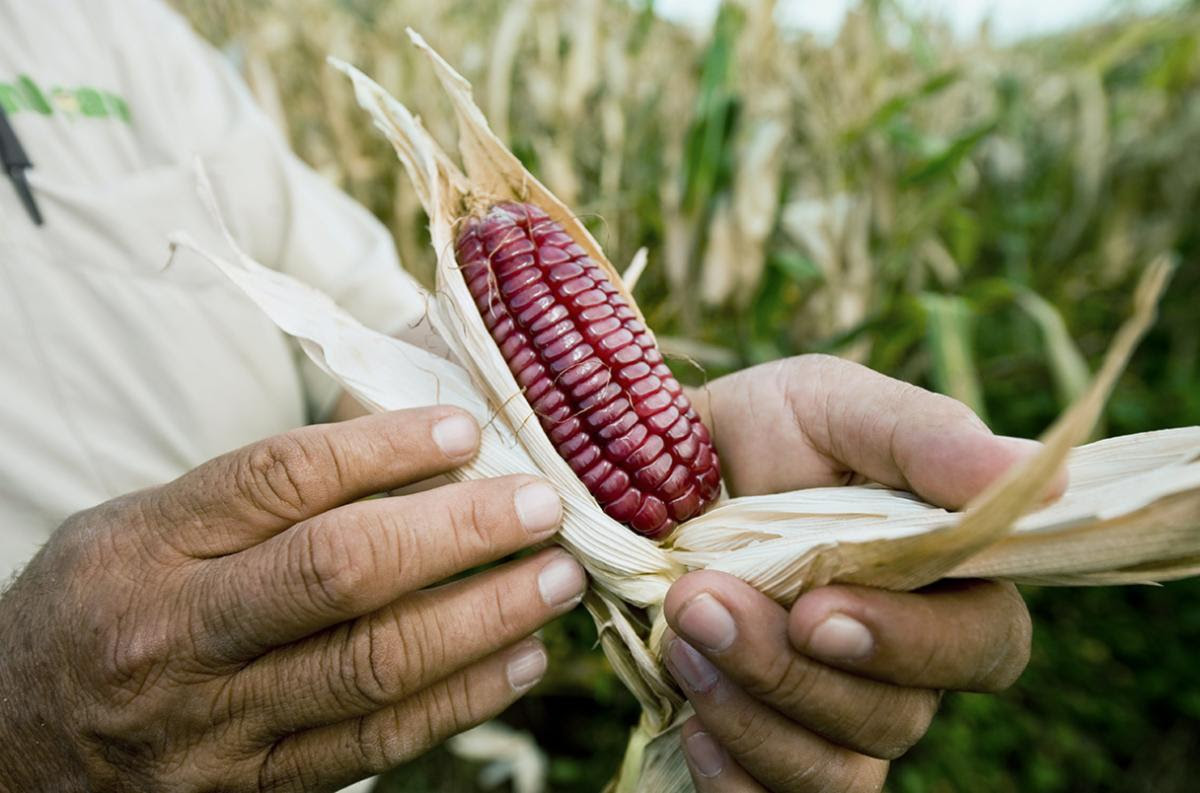|
Like all existing maize, a variety from Oaxaca, Mexico, has two different wild ancestors.Philippe Psaila/Science Source
Maize is one of the world’s most important crops, but its origins have long bedeviled scientists. It took more than a century for scientists to settle on the idea that it was domesticated about 9000 years ago in the lowlands of Mexico from a wild grass: a subspecies of teosinte called parviglumis. But now, a team of geneticists has complicated that history, reporting today in Science that maize as we know it has a second wild ancestor. Between 15% and 25% of the genes in all existing maize varieties come not from parviglumis, but from a highland subspecies of teosinte called mexicana, which hybridized with maize some 4000 years after people first domesticated the plant.
Maize is “such a well-studied and prominent plant” that it’s surprising to learn it had a long-lost relative, says Logan Kistler, an anthropologist who studies plant domestication at the Smithsonian Institution’s National Museum of Natural History. “There’s still something this basic to learn about maize—that’s wild.” But why the new hybrid spread so far and wide is still unclear.
Jeffrey Ross-Ibarra, an evolutionary biologist at the University of California, Davis, started to study the relationship of the mexicana teosinte subspecies to maize in order to understand how the lowland domesticate adapted to the chilly highlands of central Mexico. But, “We kept finding evidence of this second teosinte in other places we looked,” he says. The team examined nearly 1000 maize genomes from traditional varieties, modern cultivars, and ancient plant remains excavated from the southwestern United States to eastern Brazil. Unexpectedly, mexicana ancestry is “absolutely everywhere,” Ross-Ibarra says. Reconstructions of the maize family tree suggest it first mixed with the highland teosinte between 6000 and 4000 years ago. Indeed, the only maize sample the team found without mexicana ancestry was a 5500-year-old cob from the southern coast of Peru, thousands of kilometers away from where the hybridization was taking place.
Together, the genetic data and archaeological evidence suggest maize moved out of Mexico in two waves. After it was domesticated from parviglumis in the Balsas River Basin in what is now the state of Guerrero about 9000 years ago, maize quickly spread south along the Pacific coast, reaching Panama by 7800 years ago and Peru by 6700 years ago. The ancient cob from Peru was the result of this first wave. Then, starting about 6000 years ago, maize moved up into Mexico’s highlands, where it crossed with the local mexicana teosinte.
Shortly after, this new hybrid maize exploded out of central Mexico, mixing with or replacing every first-wave variety in Central and South America. It also headed north, reaching the southwestern U.S. about 4000 years ago. It all amounts to “a much more complete panorama of maize’s evolutionary history,” says co-author Miguel Vallebueno-Estrada, a paleogenomicist at the Gregor Mendel Institute of Molecular Plant Biology.
Just why the new hybrid varieties spread so widely is a mystery. “It made sense that introgression from mexicana was important for adaptation to the highlands,” says Maud Tenaillon, a population geneticist who studies maize at CNRS, France’s national research agency, and Paris-Saclay University. “But that it’s everywhere—it’s something no one would have guessed.”
One would think “this new maize must have had an incredible advantage” over firstwave varieties, Tenaillon says. But that’s not what Ross-Ibarra’s team found. Genetic analyses and ancient cobs show first-wave maize already had large ears, soft kernels, and other desirable traits that differentiate maize from teosinte. The researchers identified a few possible advantages in second-wave maize, including slightly bigger cobs, more kernels per row, and the ability to withstand more hours of sunlight, which could have helped as it moved north and south to places with long summer days. But nothing stands out as truly transformative. “Frustratingly, we don’t have a smoking-gun answer,” Ross-Ibarra says.
The timing might hold a clue. The mexicana hybridization happens “right on the eve of a big transition to more sedentary agriculture,” says Andrew Somerville, an archaeologist at Iowa State University. The people who domesticated maize—and, later, crossed it with mexicana—were foragers who ate a diversity of wild foods while also growing small patches of maize and other plants. But between 4700 and 4000 years ago, as second-wave maize was spreading, the plant became the main staple for some Mesoamerican communities. Many others followed suit, and before long maize agriculture was the dominant way of life in much of the Americas.
Second-wave maize might have had qualities that made the invention of agriculture possible, Ross-Ibarra says. “My best guess is that [before mexicana hybridization], you had a domesticated maize, but it was wimpy or not super-reliable,” perhaps because of inbreeding and a limited gene pool, he explains. The influx of genetic variation from the highland teosinte may have “turned it into something that is really dependable.” Or perhaps the early farmers who spread maize through migration or trade simply preferred the new varieties for cultural reasons. Ross-Ibarra is now working with archaeologists and human geneticists to trace the relationship of maize and people over time.
The new picture of its origins is a reminder of how much consumers the world over owe to ancient Indigenous farmers, Vallebueno-Estrada says. “Maize is the compendium of the work done by so many people over thousands of years. It’s thanks to them that we have maize today.”
|
 Like all existing maize, a variety from Oaxaca, Mexico, has two different wild ancestors.
Like all existing maize, a variety from Oaxaca, Mexico, has two different wild ancestors. Like all existing maize, a variety from Oaxaca, Mexico, has two different wild ancestors.
Like all existing maize, a variety from Oaxaca, Mexico, has two different wild ancestors.